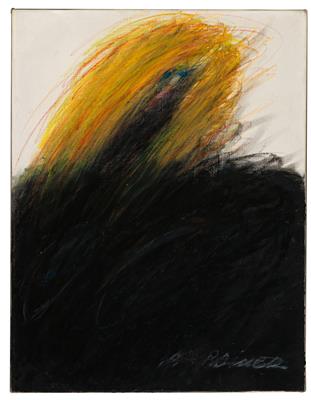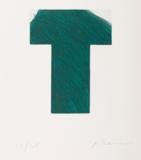Arnulf Rainer *

(born in Baden near Vienna in 1929)
“Irma la Douce”, signed A. Rainer as well as signed, dated and titled Rainer 63 “Irma la Douce” on the reverse on the canvas overlap, oil on canvas, 65 x 50.5 cm, on stretcher
Provenance:
Private Collection, Vienna
The cultured artist
Paper for the II Vienna Austria Talk “Art for What?”
Art, of course, is for everyone, and should be accessible to everyone. It’s called ACCULTURATION. Art, however, is not a subdivision of cultural administration, just as lions are not a subdivision of zoo administration, and culture is not merely the afterbirth of art. There is a problematic relationship between art and culture; artists and cultural people.
From the artist’s point of view, the problem today is mainly due to a HEDONISTIC concept of culture that is spreading everywhere, be it in highbrow or lowbrow forms. We can sense the advancement of a dangerous PLATform: CIRCENSORSHIP. Be it in the democratisation of culture or at festivals, be it in the sponsorship of American dairies or the greatest art collector of all time or in museums, everywhere a circus culture is being promoted, that encourages artist perfectionism, dressage numbers, aesthetic gimmicks and decorative tinsel, i.e. light thrills instead of cerebral stimulation, charming magic tricks instead of deep, powerful magic, repertory clowns instead of Hamm and Clov, snake women instead of Arnulf Rainer, tightrope walkers instead of irritators. New institutionalisations are on the horizon.
We’ll have to assimilate:
the Artist Coping Agencies,
the cultural fairs,
the safari and trophy businesses,
the diplomoderators,
the Ministry of Entertainment,
or at least the Undersecretary of Circus, Tenderness and Zoos.
Actions such as: “All paint without toil and trouble” and the “Studio breakfast for thousands” are waiting to be tackled. What is to be done? The artist must think about the consequences:
1. The great refusal (often used as a slogan in the troop of painters) – should not be carried out, as
Homo sapiens will not accept it.
2. The retreat: the artist can also be put under conservation like other extinct species. He exists like a high
mountain deer, desert scorpion, deep sea jellyfish, mallard, wild sow or hedgehog. (Problem: when living
space is no longer enough, “artist funding” comes in. It becomes an exercise of feeding the wildlife,
or worse, the keepers of the art become the art hunters)
3. Distance strategies and protective attitudes against appropriation, thus creating difficulties that are feared
in dressage, such as the “unruly taming”. Developing a negative image (such as “sick dog” or constant
growling).
Also proven:
a reclusive lifestyle,
geographically dispersed activities,
a fluid lifestyle, relative denial,
or playing the role of the “difficult artist”... 1979
From: Arnulf Rainer Schriften, Selbstzeugnisse und ausgewählte Interviews, Pinaktothek der Moderne. Hatje Cantz 2010
Esperta: Mag. Elke Königseder
 Mag. Elke Königseder
Mag. Elke Königseder
+43-1-515 60-358
elke.koenigseder@dorotheum.at
23.06.2021 - 16:00
- Prezzo realizzato: **
-
EUR 94.050,-
- Stima:
-
EUR 40.000,- a EUR 70.000,-
Arnulf Rainer *
(born in Baden near Vienna in 1929)
“Irma la Douce”, signed A. Rainer as well as signed, dated and titled Rainer 63 “Irma la Douce” on the reverse on the canvas overlap, oil on canvas, 65 x 50.5 cm, on stretcher
Provenance:
Private Collection, Vienna
The cultured artist
Paper for the II Vienna Austria Talk “Art for What?”
Art, of course, is for everyone, and should be accessible to everyone. It’s called ACCULTURATION. Art, however, is not a subdivision of cultural administration, just as lions are not a subdivision of zoo administration, and culture is not merely the afterbirth of art. There is a problematic relationship between art and culture; artists and cultural people.
From the artist’s point of view, the problem today is mainly due to a HEDONISTIC concept of culture that is spreading everywhere, be it in highbrow or lowbrow forms. We can sense the advancement of a dangerous PLATform: CIRCENSORSHIP. Be it in the democratisation of culture or at festivals, be it in the sponsorship of American dairies or the greatest art collector of all time or in museums, everywhere a circus culture is being promoted, that encourages artist perfectionism, dressage numbers, aesthetic gimmicks and decorative tinsel, i.e. light thrills instead of cerebral stimulation, charming magic tricks instead of deep, powerful magic, repertory clowns instead of Hamm and Clov, snake women instead of Arnulf Rainer, tightrope walkers instead of irritators. New institutionalisations are on the horizon.
We’ll have to assimilate:
the Artist Coping Agencies,
the cultural fairs,
the safari and trophy businesses,
the diplomoderators,
the Ministry of Entertainment,
or at least the Undersecretary of Circus, Tenderness and Zoos.
Actions such as: “All paint without toil and trouble” and the “Studio breakfast for thousands” are waiting to be tackled. What is to be done? The artist must think about the consequences:
1. The great refusal (often used as a slogan in the troop of painters) – should not be carried out, as
Homo sapiens will not accept it.
2. The retreat: the artist can also be put under conservation like other extinct species. He exists like a high
mountain deer, desert scorpion, deep sea jellyfish, mallard, wild sow or hedgehog. (Problem: when living
space is no longer enough, “artist funding” comes in. It becomes an exercise of feeding the wildlife,
or worse, the keepers of the art become the art hunters)
3. Distance strategies and protective attitudes against appropriation, thus creating difficulties that are feared
in dressage, such as the “unruly taming”. Developing a negative image (such as “sick dog” or constant
growling).
Also proven:
a reclusive lifestyle,
geographically dispersed activities,
a fluid lifestyle, relative denial,
or playing the role of the “difficult artist”... 1979
From: Arnulf Rainer Schriften, Selbstzeugnisse und ausgewählte Interviews, Pinaktothek der Moderne. Hatje Cantz 2010
Esperta: Mag. Elke Königseder
 Mag. Elke Königseder
Mag. Elke Königseder
+43-1-515 60-358
elke.koenigseder@dorotheum.at
|
Hotline dell'acquirente
lun-ven: 10.00 - 17.00
kundendienst@dorotheum.at +43 1 515 60 200 |
| Asta: | Arte contemporanea I |
| Tipo d'asta: | Asta in sala con Live Bidding |
| Data: | 23.06.2021 - 16:00 |
| Luogo dell'asta: | Wien | Palais Dorotheum |
| Esposizione: | 17.06. - 23.06.2021 |
** Prezzo d'acquisto comprensivo di tassa di vendita e IVA
Non è più possibile effettuare un ordine di acquisto su Internet. L'asta è in preparazione o è già stata eseguita.
Altri oggetti dell'artista
-

Stima:
EUR 3.800,- a EUR 4.500,- -

Stima:
EUR 3.000,- a EUR 4.000,- -

Stima:
EUR 3.000,- a EUR 4.000,-
